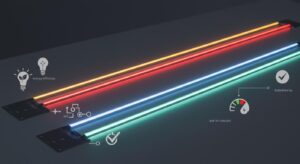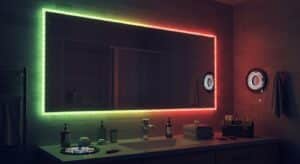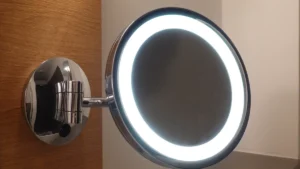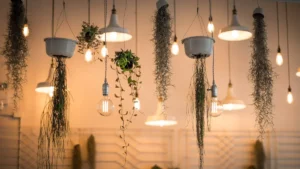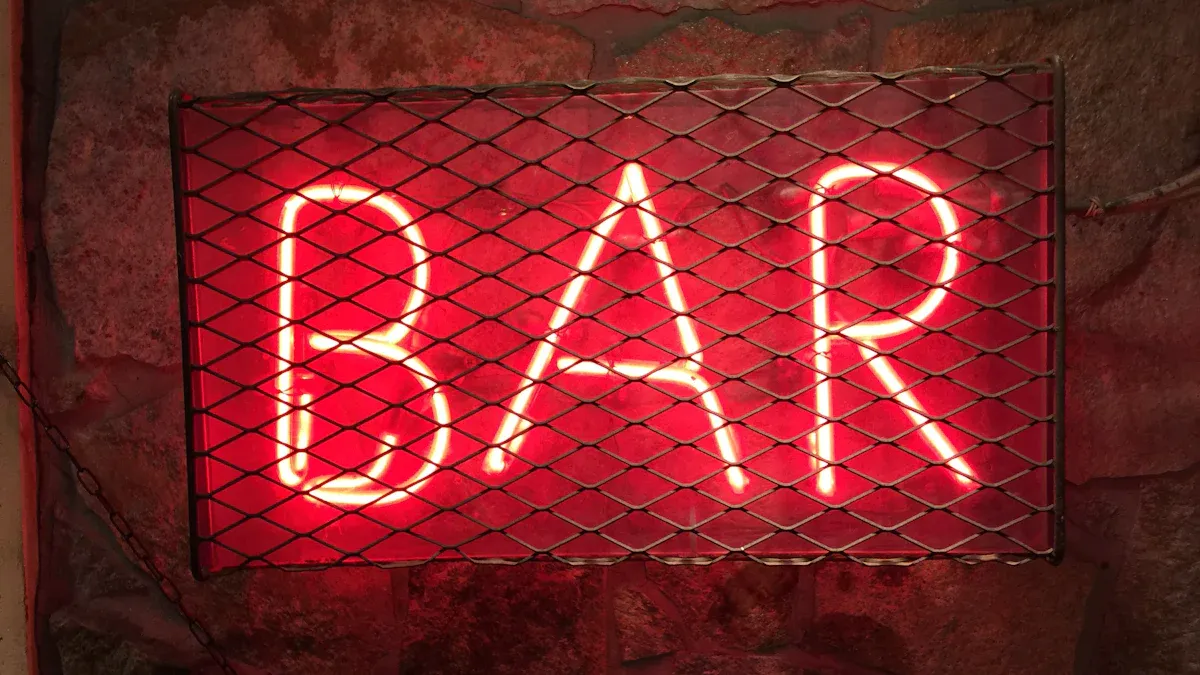
Choosing the best rigid LED bar is very important. It affects how bright and strong the light will be. A good LED bar works well for your specific needs. It can be used for cars, work areas, or outside spaces. It helps the light work well even in tough conditions. Knowing what to check for can save you time and money. You won’t need to fix or replace it often.
Key Takeaways
Always check how bright the light bar is. This helps you pick one that gives enough light.
Pick the right beam type for your needs. Spot beams shine far, while flood beams light up wide areas.
Look at the IP rating for dust and water safety. IP67 or IP69 is best for outdoor and tough weather.
Choose light bars made from strong materials like aluminium or copper. These last longer and handle heat better.
Make sure it works with your current setup. Check the voltage, wiring, and mounting to avoid problems.
Key Features to Think About When Picking a Light Bar
Brightness and Lumens
When picking a light bar, brightness is very important. Brightness is measured in lumens, which show how much light the LED bar gives off. But not all lumens are the same. There are two types: raw lumens and effective lumens. Raw lumens show the maximum possible brightness, but effective lumens show the real brightness in everyday use. Looking at effective lumens helps you pick a light bar that works well.
For instance, rigid LED bars made for outdoor use often have higher lumens to light up dark areas. A warm white LED bar might give 850 lumens per module. A neutral white bar can go up to 890 lumens per module. This shows how lumen output changes with different LED bar types.
Tip: Always check effective lumens when comparing light bars. This helps you avoid paying too much for a light bar that isn’t bright enough.
Beam Pattern Choices
The beam pattern decides how the light spreads out. Different patterns work for different needs. The main beam patterns are:
Spot Beam: A narrow, focused light for seeing far distances.
Flood Beam: A wide light spread, great for lighting big spaces.
Combo Beam: Mixes spot and flood beams for both distance and width.
If you need a light bar for off-road driving, a combo beam is a good choice. It lets you see far ahead and lights up the sides of the path. For workspaces, a flood beam is better because it covers more area.
Note: Some advanced rigid LED bars let you switch beam patterns. This makes them useful for different tasks.
Colour Temperature and Clarity
Colour temperature, measured in Kelvin (K), changes how the light looks and works. Lower temperatures (around 3000K) give warm white light, which is softer on the eyes. Higher temperatures (4000K or more) give neutral or cool white light, which makes details clearer.
For example, a warm white LED bar at 3000K usually gives 850 lumens per module. A neutral white bar at 4000K can give up to 890 lumens per module. This difference in colour temperature affects how well you see, especially in foggy or dusty places.
Tip: Pick a colour temperature that fits your surroundings. Warm white is better for indoor or close-up use. Neutral or cool white works best outdoors or for seeing far away.
IP Rating for Dust and Water Resistance
When picking a rigid LED bar, think about its toughness. The IP rating shows how well it handles dust and water. This rating has two numbers. The first number shows dust protection. The second number shows water protection.
For instance, an IP69 rating means it blocks all dust. It also resists strong, hot water jets. On the other hand, an IPX0 rating gives no water protection. Below is a table explaining IP ratings:
IP Rating | Protection Level | Description |
|---|---|---|
IP69 | Dust-tight | High-pressure, high-temperature water jets |
IPX0 | – | No protection |
IPX1 | – | Dripping water (vertically falling drops) |
IPX2 | – | Dripping water when the tilt angle ≤ 15° |
IPX3 | – | Spraying water |
IPX4 | – | Splashing water |
IPX5 | – | Water jets |
IPX6 | – | Powerful water jets |
IPX7 | – | 1 metre water emitter |
IPX8 | – | Immersion of more than 1 metre |
IPX9 | – | High-pressure, high-temperature water jets |
Tip: For outdoor use, choose a light bar with IP67 or IP69. These ratings protect against dust and water in tough conditions.
Build Quality and Materials
The strength of a rigid LED bar depends on its build. Strong materials like aluminium or copper make it last longer. These materials handle stress and harsh weather well. Flexible materials may not be as reliable.
Here’s a table comparing materials used in LED bars:
Property | Aluminium/Copper | Flexible Substrates |
|---|---|---|
Mechanical Stability | High, strong support | Weak under stress |
Environmental Resistance | Good, resists moisture/chemicals | May fail in tough conditions |
Thermal Conductivity | High, keeps light efficient | Low, can cause overheating |
Heat Management | Effective, avoids heat buildup | Poor, may lower performance |
Aluminium and copper are great for LED bars. They manage heat well and resist bad weather. This keeps the light working properly for a long time.
Note: Always pick light bars made from strong materials. They last longer and protect against dust and water better.
Using good materials ensures your LED bar works well in all conditions.
Installation and Compatibility of a Rigid LED Bar
Mounting Options and Bracket Strength
How you attach your rigid LED bar is very important. Strong brackets keep the light steady, even in tough conditions. Many LED bars have adjustable brackets. These let you change the angle of the light easily. This is helpful when you need to aim the light for different jobs.
When picking brackets, check their material and design. Aluminium brackets are light but strong, making them great for long use. Some brackets also have anti-vibration pads. These pads stop shaking and protect the light from damage.
Tip: Always test the bracket strength before setting up the light. Weak brackets can make the light wobble and mess up its aim.
Wiring and Power Requirements
Good wiring is key for your rigid LED bar to work well. Before setting it up, make sure you have the right wires and connectors. A good wiring kit includes a relay, fuse, and switch. These parts stop the system from overloading.
Check how much power the LED bar needs. Most bars use 12V or 24V systems, so they fit many vehicles. But make sure your power source can handle the bar’s energy use.
Some LED bars come with plug-and-play wiring. This makes setup easier and avoids tricky electrical work.
Note: Always follow the maker’s wiring guide. This helps prevent short circuits or damage to the light.
Measurements and Space Considerations
Before setting up a rigid LED bar, measure the space carefully. The bar’s size must match the area where you’ll mount it. For example, a 30-inch bar needs enough room for its length and width.
Think about how deep the light bar is too. Slim bars fit small spaces better. Bigger bars may need more room because of their size or cooling parts.
Tip: Use a tape measure to check the mounting space. This ensures the bar fits well and doesn’t block other parts.
Compatibility with Existing Systems
Making sure your rigid LED bar fits your setup is vital. If it doesn’t match, it could cause problems or damage. Here are key things to check for compatibility:
1. Voltage Requirements
Most rigid LED bars run on 12V or 24V systems. Check if your power source matches the LED bar’s voltage. For example, cars usually use 12V, while trucks may need 24V.
Tip: Look at your vehicle’s manual to confirm the voltage. Use a voltage converter if the power doesn’t match.
2. Electrical Connections
The LED bar’s wiring must work with your system. Some bars have universal connectors, while others need special adapters. Plug-and-play options make installation easier.
Electrical compatibility checklist:
Does the bar have the right connectors?
Are the wires long enough to reach the power source?
Is the wiring harness suitable for your system?
If the wiring doesn’t fit, you might need extra parts like relays or fuses.
3. Control Systems
Some LED bars have features like dimming or beam changes. These need a compatible control system. For example, some connect to dashboard controls, others use remotes or apps.
Note: Check if your setup supports these controls. If not, you may need a separate control module.
4. Mounting Compatibility
Your vehicle or workspace must fit the LED bar’s brackets. Some vehicles have pre-made holes, but others may need custom mounts.
Steps to check mounting compatibility:
Measure the space for the light bar.
Check the bracket size.
Make sure the brackets attach securely.
Tip: Use adjustable brackets if the mounting points don’t align.
5. Software or Firmware Updates
Some advanced LED bars need software updates to work well. If yours does, ensure your system can handle updates.
Example: A smart LED bar with app control may need a compatible phone or tablet for updates.
6. Heat Management Systems
LED bars create heat when used. Your setup must allow airflow to stop overheating. For example, don’t place the bar near parts that block air.
Tip: Choose LED bars with heat sinks or cooling fans. These help in tight spaces.
By checking these points, your rigid LED bar will work smoothly with your system. This improves performance and makes your equipment last longer.
Budget and Maintenance for a 30-Inch Light Bar
Cost-Effectiveness and Value
When picking a 30-inch light bar, think about its value. A good-quality light bar may cost more at first. However, it saves money over time by lasting longer. Strong materials like aluminium make it durable and reduce the need for replacements. Features like adjustable beams and high brightness also make it more useful.
Check the warranty too. Many brands offer warranties for repairs or defects. This gives you confidence and ensures your money is well spent.
Tip: Read reviews and compare warranties before buying. Spending a bit more can mean better quality and support.
Energy Efficiency and Savings
Energy efficiency is very important. LED lights use less power than older types of lighting. This helps your vehicle’s battery last longer and lowers energy costs. For example, an efficient 30-inch light bar can give bright light while using little power.
Look for energy-saving features like dimming or smart controls. These let you adjust the brightness to save power when needed.
Note: Check the energy rating of the light bar. Higher ratings mean better efficiency and long-term savings.
Cleaning and Maintenance Tips
Taking care of your 30-inch light bar keeps it working well. Clean it often to stop dust and dirt from blocking the light. Use a soft cloth with 99.7% isopropyl alcohol to clean the lens and body.
Stick to a cleaning schedule to keep all parts in good shape. Below is a table showing how often to clean each part:
Area | Cleaning Method | How Often |
|---|---|---|
Printhead | Solvent* | After every roll of media (or 500 feet of fanfold media) for Direct Thermal Mode; After every roll of ribbon for Thermal Transfer Mode. |
Platen roller | Solvent* | When needed. |
Media sensors | Air blow | When needed. |
Ribbon sensor | Air blow | When needed. |
Media path | Solvent* | When needed. |
Ribbon path | Solvent* | When needed. |
Cutter module | Solvent* | After every roll of media (or more often, depending on use). |
Tear-off/peel-off bar | Solvent* | Once a month. |
Take-label sensor | Air blow | Every six months. |
Tip: Use a maintenance kit for cleaning. This keeps all parts working well and makes your light bar last longer.
Warranty and Support
When buying a 30-inch light bar, check the warranty and support. A good warranty protects you from defects or problems. It shows the maker trusts their product. Always find out how long the warranty lasts. Many trusted brands offer warranties from one to five years.
Look at what the warranty covers. Some only cover factory defects. Others include accidental damage or normal wear. A full warranty gives you peace of mind and saves money on repairs.
Tip: Keep your receipt and warranty card safe. You’ll need them if you claim warranty services.
Customer support is also very important. Good support teams help with setup, fixing issues, or finding parts. Choose brands with many ways to contact them, like phone, email, or chat. Fast replies and helpful staff make solving problems easier.
Some brands also have online guides, FAQs, and videos. These can help you fix small issues without needing extra help.
Note: Before buying, check reviews about the brand’s customer service. Other buyers’ experiences can tell you a lot.
Picking a light bar with a strong warranty and good support ensures you get the best value and long-term use.
Picking the right rigid LED bar needs careful thought. Focus on brightness, strength, and how well it fits your setup. Using less energy, strong materials, and flexible designs gives top performance. The table below shows key features to look for:
Feature | What It Does | Why It Matters |
|---|---|---|
Energy Efficiency | Uses less power than older lights. | Saves money and gives brighter light. |
Durability | Lasts longer and handles shocks or vibrations well. | Makes it reliable and long-lasting. |
Compatibility | Comes in different sizes and designs for various uses. | Easy to fit into your current setup. |
It’s important to balance quality, use, and cost. For instance, 80 CRI lights work well in general areas and save money. Higher CRI lights are better for places needing clear details. Spending more on high-quality options may cost more now but saves money later.
Tip: Think about what you need most. Pick a light bar that matches your needs. A smart choice gives great results and good value.
FAQ
How should I clean a rigid LED bar?
Use a soft cloth with isopropyl alcohol to wipe it. Don’t use rough materials that might scratch the surface. Cleaning often stops dirt build-up and keeps the light bright.
Can rigid LED bars handle bad weather?
Yes, many rigid LED bars have strong IP ratings like IP67 or IP69. These ratings protect them from dust and water, making them good for tough conditions.
How do I pick the right beam pattern?
Spot beams shine far for long-distance views. Flood beams spread light wide for big areas. Combo beams mix both for distance and width. Think about your needs, like driving off-road or lighting workspaces.
Is installing a rigid LED bar hard?
Most rigid LED bars have adjustable brackets and easy wiring. Follow the maker’s instructions for simple setup. Check the space and power source to make sure they fit the bar.
How can I make my rigid LED bar last longer?
Pick one made from strong materials like aluminium. Clean it often and stop overheating by allowing airflow. Check the warranty for extra protection against problems.
See Also
Five Key Suggestions for Choosing Ideal Backlit Bar Signs
A Comparison of Flexible Versus Rigid LED Strips
Crucial Guidance for Selecting the Appropriate LED Sign Module
Guidelines for Picking the Best Neon Rope Lighting Options
Selecting Optimal LED Strip Lights: SUNLITE LED’s Five Essential Tips
